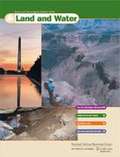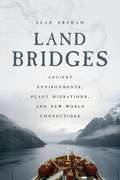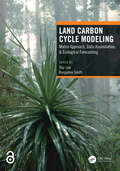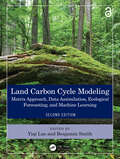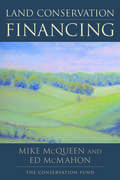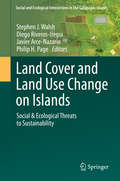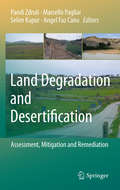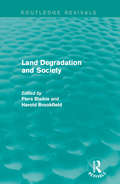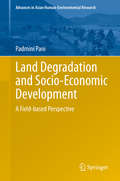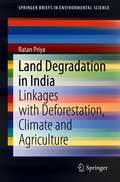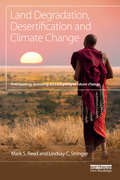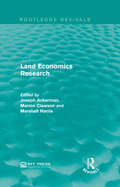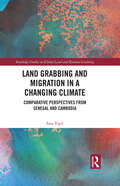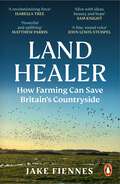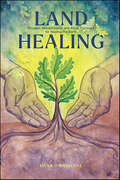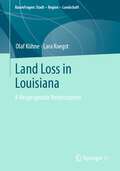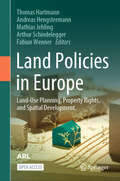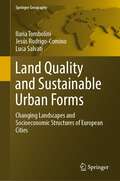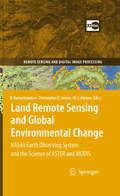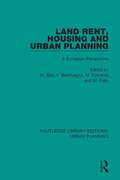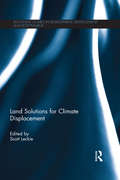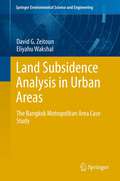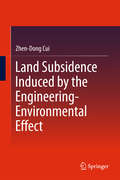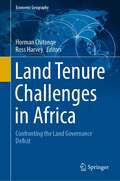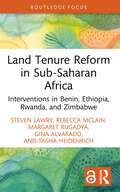- Table View
- List View
Land And Water
by National Science Resources CenterThe land and the water are always changing. Water flows over the land, carving valleys and wearing down the landscape. Forces inside Earth move continents, build mountains, and cause volcanic eruptions and earthquakes. If no rain falls, our water supplies dry up, and the land becomes cracked and parched.
Land Bridges: Ancient Environments, Plant Migrations, and New World Connections
by Alan GrahamLand bridges are the causeways of biodiversity. When they form, organisms are introduced into a new patchwork of species and habitats, forever altering the ecosystems into which they flow; and when land bridges disappear or fracture, organisms are separated into reproductively isolated populations that can evolve independently. More than this, land bridges play a role in determining global climates through changes to moisture and heat transport and are also essential factors in the development of biogeographic patterns across geographically remote regions. In this book, paleobotanist Alan Graham traces the formation and disruption of key New World land bridges and describes the biotic, climatic, and biogeographic ramifications of these land masses’ changing formations over time. Looking at five land bridges, he explores their present geographic setting and climate, modern vegetation, indigenous peoples (with special attention to their impact on past and present vegetation), and geologic history. From the great Panamanian isthmus to the boreal connections across the North Atlantic and North Pacific Oceans that allowed exchange of organisms between North America, Europe, and Asia, Graham’s sweeping, one-hundred-million-year history offers new insight into the forces that shaped the life and land of the New World.
Land Carbon Cycle Modeling: Matrix Approach, Data Assimilation, & Ecological Forecasting
by Benjamin Smith Yiqi LuoCarbon moves through the atmosphere, through the oceans, onto land, and into ecosystems. This cycling has a large effect on climate – changing geographic patterns of rainfall and the frequency of extreme weather – and is altered as the use of fossil fuels adds carbon to the cycle. The dynamics of this global carbon cycling are largely predicted over broad spatial scales and long periods of time by Earth system models. This book addresses the crucial question of how to assess, evaluate, and estimate the potential impact of the additional carbon to the land carbon cycle. The contributors describe a set of new approaches to land carbon cycle modeling for better exploring ecological questions regarding changes in carbon cycling; employing data assimilation techniques for model improvement; and doing real- or near-time ecological forecasting for decision support. This book strives to balance theoretical considerations, technical details, and applications of ecosystem modeling for research, assessment, and crucial decision making. Key Features Helps readers understand, implement, and criticize land carbon cycle models Offers a new theoretical framework to understand transient dynamics of land carbon cycle Describes a suite of modeling skills – matrix approach to represent land carbon, nitrogen, and phosphorus cycles; data assimilation and machine learning to improve parameterization; and workflow systems to facilitate ecological forecasting Introduces a new set of techniques, such as semi-analytic spin-up (SASU), unified diagnostic system with a 1-3-5 scheme, traceability analysis, and benchmark analysis, for model evaluation and improvement Related Titles Isabel Ferrera, ed. Climate Change and the Oceanic Carbon Cycle: Variables and Consequences (ISBN 978-1-774-63669-5) Lal, R. et al., eds. Soil Processes and the Carbon Cycle (ISBN 978-0-8493-7441-8) Windham-Myers, L., et al., eds. A Blue Carbon Primer: The State of Coastal Wetland Carbon Science, Practice and Policy (ISBN 978-0-367-89352-1)
Land Carbon Cycle Modeling: Matrix Approach, Data Assimilation, Ecological Forecasting, and Machine Learning
by Benjamin Smith Yiqi LuoCarbon moves through the atmosphere, through the oceans, onto land, and into ecosystems. This cycling has a large effect on climate – changing geographic patterns of rainfall and the frequency of extreme weather – and is altered as the use of fossil fuels adds carbon to the cycle. The dynamics of this global carbon cycling are largely predicted over broad spatial scales and long periods of time by Earth system models. This book addresses the crucial question of how to assess, evaluate, and estimate the potential impact of the additional carbon to the land carbon cycle. The contributors describe a set of new approaches to land carbon cycle modeling for better exploring ecological questions regarding changes in carbon cycling; employing data assimilation techniques for model improvement; doing real- or near-time ecological forecasting for decision support; and combining newly available machine learning techniques with process-based models to improve prediction of the land carbon cycle under climate change. This new edition includes seven new chapters: machine learning and its applications to carbon cycle research (five chapters); principles underlying carbon dioxide removal from the atmosphere, contemporary active research and management issues (one chapter); and community infrastructure for ecological forecasting (one chapter).Key Features Helps readers understand, implement, and criticize land carbon cycle models Offers a new theoretical framework to understand transient dynamics of the land carbon cycle Describes a suite of modeling skills – matrix approach to represent land carbon, nitrogen, and phosphorus cycles; data assimilation and machine learning to improve parameterization; and workflow systems to facilitate ecological forecasting Introduces a new set of techniques, such as semi-analytic spin-up (SASU), unified diagnostic system with a 1-3-5 scheme, traceability analysis, and benchmark analysis, and PROcess-guided machine learning and DAta-driven modeling (PRODA) for model evaluation and improvement Reorganized from the first edition with seven new chapters added Strives to balance theoretical considerations, technical details, and applications of ecosystem modeling for research, assessment, and crucial decision-making
Land Conservation Financing
by Edward T. Mcmahon The Conservation Fund Mike McqueenWritten by two of the nation's leading experts on land conservation, Land Conservation Financing provides a comprehensive overview of successful land conservation programs -- how they were created, how they are funded, and what they've accomplished -- along with detailed case studies from across the United States.The authors present important new information on state-of-the-art conservation financing, showcasing programs in states that have become the nation's leaders in open-space protection: California, Colorado, Florida, Illinois, Maryland, Massachusetts, Minnesota, and New Jersey. They look at key local land protection efforts by examining model programs in DeKalb County, Georgia; Douglas County, Colorado; Jacksonville, Florida; Lake County, Illinois; Lancaster County, Pennsylvania; Marin County, California; the St. Louis metro area in Missouri and Illinois, and on Cape Cod, Massachusetts.The authors then examine how hundreds of communities have created hundreds of millions of dollars in funding by developing successful campaigns to win land conservation ballot measures. They offer case studies and pull together lessons learned as they lay out how to run a successful campaign. The authors also consider the role of private foundations, which have made immense contributions to land conservation over the past two decades.The book concludes with an examination of the emerging concept of green infrastructure -- a strategic approach to conservation that involves planning and managing a network of parks, natural areas, greenways, and working lands that can help support native species, maintain ecological processes, and contribute to the health and quality of life for America's people and its communities.Land Conservation Financing is an indispensable resource for land conservationists in the public and private sectors who are looking for a detailed, national portrait of the state of land conservation in America today.
Land Cover and Land Use Change on Islands: Social & Ecological Threats to Sustainability (Social and Ecological Interactions in the Galapagos Islands)
by Stephen J. Walsh Philip H. Page Diego Riveros-Iregui Javier Arce-NazarioGlobalization is not a new phenomenon, but it is posing new challenges to humans and natural ecosystems in the 21st century. From climate change to increasingly mobile human populations to the global economy, the relationship between humans and their environment is being modified in ways that will have long-term impacts on ecological health, biodiversity, ecosystem goods and services, population vulnerability, and sustainability. These changes and challenges are perhaps nowhere more evident than in island ecosystems. Buffeted by rising ocean temperatures, extreme weather events, sea-level rise, climate change, tourism, population migration, invasive species, and resource limitations, islands represent both the greatest vulnerability to globalization and also the greatest scientific opportunity to study the significance of global changes on ecosystem processes, human-environment interactions, conservation, environmental policy, and island sustainability.In this book, we study islands through the lens of Land Cover/Land Use Change (LCLUC) and the multi-scale and multi-thematic drivers of change. In addition to assessing the key processes that shape and re-shape island ecosystems and their land cover/land use changes, the book highlights measurement and assessment methods to characterize patterns and trajectories of change and models to examine the social-ecological drivers of change on islands. For instance, chapters report on the results of a meta-analysis to examine trends in published literature on islands, a satellite image time-series to track changes in urbanization, social surveys to support household analyses, field sampling to represent the state of resources and their limitations on islands, and dynamic systems models to link socio-economic data to LCLUC patterns. The authors report on a diversity of islands, conditions, and circumstances that affect LCLUC patterns and processes, often informed through perspectives rooted, for instance, in conservation, demography, ecology, economics, geography, policy, and sociology.
Land Degradation and Desertification: Assessment, Mitigation and Remediation
by Selim Kapur Angel Faz Cano Marcello Pagliai Pandi ZdruliLand Degradation and Desertification: Assessment, Mitigation, and Remediation reports research results in sustainable land management and land degradation status and mitigation in 36 countries around the world. It includes background papers with continental and international perspectives dealing with land degradation and desertification studies. The book assembles various topics of interest for a large audience. They include carbon sequestration and stocks, modern techniques to trace the trends of land degradation, traditional and modern approaches of resource-base conservation, soil fertility management, reforestation, rangeland rehabilitation, land use planning, GIS techniques in desertification risk cartography, participatory ecosystem management, policy analyses and possible plans for action. Various climatic domains in Africa, Asia, Europe and The Americas are covered. The book will be of interest to a variety of environmental scientists, agronomists, national and international policy makers and a number of organizations dealing with sustainable management of natural resources.
Land Degradation and Society (Routledge Revivals)
by Harold Brookfield Piers BlaikieWhy does land management so often fail to prevent soil erosion, deforestation, salination and flooding? How serious are these problems, and for whom? This book, first published in 1987, sets out to answer these questions, which are still some of the most crucial issues in development today, using an approach called ‘regional political ecology’. This approach acknowledges that the reason why land management can fail are extremely varied, and must include a thorough understanding of the changing natural resource base itself, the human response to this, and broader changes in society, of which land managers are a part. Land Degradation and Society is essential reading for all students of geography, agriculture, social sciences, development studies and related subjects.
Land Degradation and Socio-Economic Development: A Field-based Perspective (Advances in Asian Human-Environmental Research)
by Padmini PaniThis book offers an overview of recent literature on land degradation and its interrelationship with socio-economic development processes in the developing world. It provides an in-depth analysis of land degradation as a physical process, with an emphasis on the local and regional scales. The volume contains a detailed case-study of ravine formation processes in the Chambal valley, a unique but least studied part of the world. Using multi-scale and multi-disciplinary approaches, and combining spatial socio-economic data with remote sensing data, this book provides an in-depth analysis of the causes and implications of land degradation.
Land Degradation in India: Linkages with Deforestation, Climate and Agriculture (SpringerBriefs in Environmental Science)
by Ratan PriyaThis book discusses land degradation in India using statistical tools such as Principal Component Analysis (PCA) and Regression Analysis (RA), and uses statistical analyses and graphical representations of the causal relationship between land degradation and land productivity to determine linkages with deforestation, climate change and agricultural productivity. While most studies of land degradation in India focus on economic outcomes and physical processes at macro and micro levels, this study addresses land degradation at the meso-level to fill in this gap and provide up-to-date information on often overlooked factors associated with land degradation issues using the latest available data. Districts in the study were selected by land degradation intensity, forming an index of the severity of land degradation in the area, with a focus on gullied lands, soil salinity/alkalinity and open and dense scrubs as indicators. Though the study areas are in India, researchers, policy makers and students around the world will be able to learn from these inputs regarding land degradation to address various challenges associated with sustainable land management and agricultural productivity.
Land Degradation, Desertification and Climate Change: Anticipating, assessing and adapting to future change
by Mark S. Reed Lindsay C. StringerAlthough much is known about the processes and effects of land degradation and climate change, little is understood about the links between them. Less still is known about how these processes are likely to interact in different social-ecological systems around the world, or how societies might be able to adapt to this twin challenge. This book identifies key vulnerabilities to the combined effects of climate change and land degradation around the world. It identifies triple-win adaptations that can tackle both climate change and land degradation, whilst supporting biodiversity and ecosystem services. The book discusses methods for monitoring effects of climate change and land degradation, and adaptations to these processes. It argues for better co-operation and knowledge exchange, so that the research, land user and policy communities can work together more effectively to tackle these challenges, harnessing the "wisdom of crowds" to assess vulnerability and adapt to climate change and land degradation, whilst protecting livelihoods and biodiversity.
Land Economics Research: Papers Presented At A Symposium Held At Lincoln, Nebraska, June 16-23, 1961 (Routledge Revivals)
by Marshall Harris Marion Clawson Joseph AckermanOriginally published in 1962, Land Economics Research brings together papers presented at a symposium in Nebraska in 1961 which deal with ideas, theories and suggestions in land economics to encourage problem-solving in American land issues. This report draws on all types of land, all situations and all economics problems related to land issues. This title will be of interest to students of Environmental Studies and Economics as well as professionals.
Land Grabbing and Migration in a Changing Climate: Comparative Perspectives from Senegal and Cambodia (Routledge Studies in Global Land and Resource Grabbing)
by Sara VigilThis book provides a theoretical and empirical examination of the links between environmental change, land grabbing, and migration, drawing on research conducted in Senegal and Cambodia. While the impacts of environmental change on migration and of environmental discourses on land grabs have received increased attention, the role of both environmental and migration narratives in shaping migration by modifying access to natural resources has remained under-explored. Using a variegated geopolitical ecology framework and a comparative global ethnographic approach, this book analyses the power of mainstream adaptation and security frameworks and how they impact the lives of marginalised and vulnerable communities in Senegal and Cambodia. Findings across the cases show how environmental and migration narratives, linked to adaptation and security discourses, have been deployed advertently or inadvertently to justify land capture, leading to interventions that often increase, rather than alleviate, the very pressures that they intend to address. The interrelations between these issues are inherent to the tensions that exist, in different contexts and at different times, between capital accumulation and political legitimation. The findings of the book point to the urgency for researchers and policymakers to address the structural causes, and not the symptoms, of both environmental destruction and forced migration. It shows how acting upon environmental change, land grabs, and migration in isolated or binary manners can increase, rather than alleviate, pressures on those most socio-environmentally vulnerable. This book will be of interest to students, scholars, and practitioners working on the topics of land and resource grabbing and environmental change and migration. The book will also be of interest to those analysing political ecology transitions in Africa and Asia, as well as to those interested in novel theoretical and methodological frameworks.
Land Healer: How Farming Can Save Britain’s Countryside
by Jake Fiennes'Jake Fiennes is changing the face of farming in Britain... a revolutionising force' Isabella TreeOur relationship with our land is broken: we must heal it.Jake Fiennes is on a mission to change the face of the English countryside. As Conservation Manager at Holkham in Norfolk, one of the country's largest historic country estates, his radical habitat restoration and agricultural work has nurtured its species and risen its crop yields - bringing back wetlands, hedgerows, birds and butterflies over 25,000 acres of land.But this isn't rewilding - there is no 'wild' in Britain anymore. Mass farming, crop science and industrial chemicals have destroyed the majority of our natural landscape and wildlife over the last century. Land Healer is the story of Fiennes's ambition to bring back our flora and fauna - by reclaiming our traditions and trialling new experiments which could restore our symbiosis with our land, and save our shared future.Following the farming year and the natural cycle of the seasons, Land Healer chronicles a life of conservation lived at the edges, and is a manifesto for rethinking our relationship with the natural world before it's too late.
Land Healing: Physical, Metaphysical, and Ritual Practices for Healing the Earth
by Dana O'DriscollA comprehensive guide to land healing for neopagans and Earth-based spiritual practitioners. This volume is for anyone with a desire to regenerate the natural world and heal the damage caused by humans. With the tools and information presented here, readers will be able to take up the path of the land healer with care, reverence, and respect to all beings. Land Healing covers a range of physical healing topics, such as gardening, permaculture, creating refugia, and wild tending. It also delves deeply into metaphysical healing, with ritual and chant work, energetic healing, palliative care, meditations, psychopomp work, and much more. Additionally, the book covers creating an earth healer&’s crane bag, witnessing and deep listening, and spiritual self-care. The goal of this book is to offer a wide range of physical and metaphysical tools and practices to address the challenges of the present age and bring forth a brighter tomorrow.
Land Loss in Louisiana: A Neopragmatic Redescription (RaumFragen: Stadt – Region – Landschaft)
by Olaf Kühne Lara KoegstThis book is oriented on testing and developing the neopragmatic approach of horizontal geographies, in which we follow approaches of natural sciences, social sciences, and cultural studies. Regional focus is thereby put on a rapidly changing elemental space and its social representations, characterized by unstable and not well-defined hybridities: coastal Louisiana. This region is highly dynamic: the Mississippi River in particular, with its extensive sediments, has shifted the coastal fringe of present-day Louisiana into the Gulf of Mexico. This land gain is contrasted by natural processes, but also by processes resultant of human intervention which cause marine encroachment. A complex interplay of different aspects is directly and indirectly leading to coastal land loss which makes the question of how to describe emerging hybrid spaces virulent and highlights the limits of a positivist understanding of boundaries that is also physically geographical. In the neopragmatic tradition, positivist research findings will be framed in social constructivist terms and supplemented by phenomenological approaches to Louisiana's coastal space, thus suggesting the need for and potentials of horizontal geographic integration of different theoretical and methodological approaches as well as researcher perspectives and data bases.
Land Policies in Europe: Land-Use Planning, Property Rights, and Spatial Development
by Thomas Hartmann Andreas Hengstermann Mathias Jehling Arthur Schindelegger Fabian WennerLand is a scarce resource. How can conflicting claims to land be reconciled? How can more housing be provided and, at the same time, the ecological goal of reducing land take be met? In many European countries, land-use planning is facing increasing and oftentimes contradictory challenges. This forms a land question, which requires land policies that can deal with the fraught relationship between planning and private property rights. A legislativereflex is to adapt planning laws. Oftentimes, such changes lack a deeper reflection of land policy and its implications. Especially an international comparison can foster a structured reflection of the own land policy.This thought-provoking book compiles a remarkable collection of 12 cases unveiling how land policies work. Curated by leading experts in the field, it takes the reader on a journey through the multifaceted realm of land policies across the continent. This book offers valuable insights into the complex interplay between land use, and property rights. "Land Policies in Europe" isn't just a book; it's a conversation starter equally relevant for experienced academics or young students, policymakers, and practitioners. This is an open access book.
Land Quality and Sustainable Urban Forms: Changing Landscapes and Socioeconomic Structures of European Cities (Springer Geography)
by Ilaria Tombolini Jesús Rodrigo-Comino Luca SalvatiIn the panorama of studies related to the ability of lands to support both natural processes and agricultural production activities, this research introduces a still unexplored or under-studied theme which is that of the relationship between urban sprawl in its various forms and land quality.The first part of the book is dedicated to the motivations and the theoretical premises from which the research originates, connected to the concept of land and those of sustainable urban form. The second part concerns the complex path towards a sustainable use of land, both in terms of institutional and regulatory measures, and in terms of knowledge and understanding of soil degradation processes. This research focuses on the Mediterranean area which is discussed in more detail in the third part. In this part of Europe we try to establish relationships between settlement dynamics and land quality: here fragile ecosystems are diffused both from a biological point of view. physical as well as socio-economic, here we find landscapes that are particularly sensitive to land degradation processes (subject to land degradation, considered the antipodes of land quality) and which in recent decades have been particularly affected by anthropic pressure.In the fourth part, an analysis is presented concerning 76 metropolitan areas representative of southern Europe. The methodology used in this analysis is based on the relationship that exists between soil sealing (or soil waterproofing) and land degradation (or land degradation) aimed at an interpretation, at the metropolitan scale, of how in southern Europe the pattern of Urbanization (compact, dispersive, intermediate) affects the land's ability to support both natural processes and agricultural production activities in a diversified way. In particular, the data on land quality and data on land use were considered together in order to analyze the processes of urban growth and the occupation of productive land for a very large area that includes Greece, France, Italy, Spain, Portugal and some parts of the Adriatic coast.There is still a long way to go, in terms of sharing, integration and definition of strategies aimed at achieving certain targets. A necessary and innovative look towards land quality could help to consider the protection of the soil as a whole, even at the planning level.
Land Remote Sensing and Global Environmental Change
by Michael J. Abrams Christopher O. Justice Bhaskar RamachandranLand Remote Sensing and Global Environmental Change: The Science of ASTER and MODIS is an edited compendium of contributions dealing with ASTER and MODIS satellite sensors aboard NASA's Terra and Aqua platforms launched as part of the Earth Observing System fleet in 1999 and 2002 respectively. This volume is divided into six sections. The first three sections provide insights into the history, philosophy, and evolution of the EOS, ASTER and MODIS instrument designs and calibration mechanisms, and the data systems components used to manage and provide the science data and derived products. The latter three sections exclusively deal with ASTER and MODIS data products and their applications, and the future of these two classes of remotely sensed observations.
Land Rent, Housing and Urban Planning: A European Perspective (Routledge Library Editions: Urban Planning #3)
by M. Ball, V. Bentivegna, M. Edwards and M. FolinOriginally published in 1985, Land Rent, Housing and Urban Planning looks at the crucial social relationships associated with land ownership, and how these have played a crucial role in the economic development of many societies. The understanding of these relationships within modern capitalist societies has proved difficult. Land ownership relations emerge as requiring specific historical analysis for specific periods and societies and as being integral aspects of the capitalist mode of production as a whole – not merely mechanisms which redistribute some independently-determined surplus.
Land Solutions for Climate Displacement (Routledge Studies in Development, Displacement and Resettlement)
by Scott LeckieThe threat of climate displacement looms large over a growing number of countries. Based on the more than six years of work by Displacement Solutions in ten climate-affected countries, academic work on displacement and climate adaptation, and the country-level efforts of civil society groups in several frontline countries, this report explores the key contention that land will be at the core of any major strategy aimed at preventing and resolving climate displacement. This innovative and timely volume coordinated and edited by the Founder of Displacement Solutions, Scott Leckie, examines a range of legal, policy and practical issues relating to the role of land in actively addressing the displacement consequences of climate change. It reveals the inevitable truth that climate displacement is already underway and being tackled in countries such as Bangladesh, Kiribati, Papua New Guinea, Solomon Islands, Tuvalu and the United States, and proposes a series of possible land solution tools that can be employed to protect the rights of people and communities everywhere should they be forced to flee the places they call home.
Land Subsidence Analysis in Urban Areas
by David G. Zeitoun Eliyahu WakshalCities built on unconsolidated sediments consisting of clays, silt, peat, and sand, are particularly susceptible to subsidence. Such regions are common in delta areas, where rivers empty into the oceans, along flood plains adjacent to rivers, and in coastal marsh lands. Building cities in such areas aggravates the problem for several reasons: 1. Construction of buildings and streets adds weight to the region causing additional soil deformations. 2. Often the regions have to be drained in order to be occupied. This results in lowering of the water table and leads to hydro-compaction. 3. Often the groundwater is used as a source of water for both human consumption and industrial use. 4. Levees and dams are often built to prevent or control flooding. Earth fissures caused by ground failure in areas of uneven or differential compaction have damaged buildings, roads and highways, railroads, flood-control structures and sewer lines. As emphasized by Barends , "in order to develop a legal framework to claims and litigation, it is essential that direct and indirect causes of land subsidence effects can be quantified with sufficient accuracy from a technical and scientific point of view." Most existing methods and software applications treat the subsidence problem by analyzing one of the causes. This is due to the fact that the causes appear at different spatial scales. For example, over-pumping creates large scale subsidence, while building loading creates local subsidence/consolidation only. Then, maximum permissible land subsidence (or consolidation) is a constraint in different management problems such as: groundwater management, planning of town and/or laws on building construction. It is, therefore, necessary to quantify the contribution of each cause to soil subsidence of the ground surface in cities urban area. In this text book, we present an engineering approach based on the Biot system of equations to predict the soil settlement due to subsidence, resulting from different causes. Also we present a case study of The Bangkok Metropolitan Area (BMA).
Land Subsidence Induced by the Engineering-Environmental Effect
by Zhen-Dong CuiThis book brings forward the concept of the geology-environmental capacity of ground buildings. It quantifies the geology-environmental capacity of ground buildings by analyzing the main factors of land subsidence and setting up the evaluation system. The geological environmental capacity of ground buildings is mainly controlled by the land subsidence and the output is the floor area ratio. According to the different geology structures and the different requirements of subsidence control in the soft soil areas in Shanghai, the evaluation system of the floor area ratio is built up by the adaptive neuro-fuzzy inference system (ANFIS) and the floor area ratios of four typical regions (Lujiazui, Xujiahui, Zhongyuan and Changqiao) are obtained by the ANFIS to offer references for urban planning. By taking the typical soft soil areas in Shanghai as case studies, this book will provide valuable insights to professors and graduate students in the field of Geotechnical Engineering, Civil Engineering, Engineering Geology and Environmental Geology.
Land Tenure Challenges in Africa: Confronting the Land Governance Deficit (Economic Geography)
by Horman Chitonge Ross HarveyThis book provides a significant contribution to the literature on land reform in various African contexts. While the economic evidence is clear that secure property rights are a necessary condition for catalysing broad-based economic development, the governance process by which those rights are secured is less clear. This book details the historical complexity of land rights and the importance of understanding this history in the process of trying to improve tenure security. Through a combination of single country case studies, comparative case studies and regional comparisons, the book is unequivocal that good governance is paramount for improving the performance of land reform programmes. All attempts at moving towards more formal secure tenure require congruence with informal norms, beliefs and values, and a set of clear systems and processes to avoid corruption and unintended negative consequences.
Land Tenure Reform in Sub-Saharan Africa: Interventions in Benin, Ethiopia, Rwanda, and Zimbabwe (Routledge Focus on Environment and Sustainability)
by Steven Lawry Rebecca McLain Margaret Rugadya Gina Alvarado Tasha HeidenrichThis book examines the impacts of land tenure reform interventions implemented in Benin, Ethiopia, Rwanda, and Zimbabwe. Since 2000, many African countries have introduced programs aimed at providing smallholder farmers with low-cost certificates for land held under customary tenure. Yet there are many contending views and debates on the impact of these land policies and this book reveals how tenure security, agricultural productivity, and social inclusion were affected by the interventions. It analyses the results of carefully selected, authoritative studies on interventions in Benin, Ethiopia, Rwanda, and Zimbabwe and applies a realist synthesis methodology to explore the socio-political and economic contexts. Drawing on these results, the book argues that inadequate attention paid to the core characteristics of rural social systems obscures the benefits of customary tenure while overlooking the scope for reforms to reduce the gaps in social status among members of customary communities. This book will be of great interest to students and scholars of land management and use, land and property law, tenure security, agrarian studies, political economy, and sustainable development. It will also appeal to development professionals and policymakers involved in land governance and land policy in Africa.
